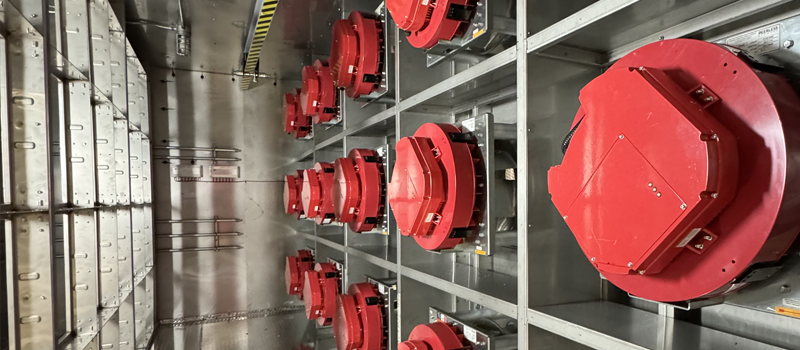Motor Efficiency: The Key to Shifting Power from HVAC to AI for Better ROI
As AI stretches data center electrical capacity, the motors behind cooling systems can be a source of untapped potential.
By Anthony Lou, Industry Perspectives
July 14, 2025

By 2035, data center electricity demand is projected to more than double, potentially reaching 440TWh. That’s the equivalent of adding the electricity demand of the entire state of California to the U.S. grid.
Much of this growth can be attributed to the widespread use of AI. It’s projected that AI workloads will represent 50% to 70% of data center demand by 2030. As AI workloads increase, data center operators face a challenge: optimizing energy for both cooling and IT within allotted power constraints, which are set by the electrical infrastructure capacity of the data center.
For years, I’ve helped HVAC manufacturers design efficient fans and pumps for mission-critical data centers. Meeting the needs of an AI revolution with a constrained electric grid requires rethinking one of the biggest hidden energy users: motors.
Motors play a significant role in data centers, powering servers and cooling equipment. In this article, I’ll focus on motors powering cooling equipment. Advanced motor technology for cooling has the potential to reduce data center energy consumption while opening up more IT capacity for new AI workloads that can positively impact the bottom line.
The Problem with Conventional Motor
In large facilities, hundreds of thousands of motors drive critical air handling and cooling systems. Demand for them is increasing, yet most traditional motors waste energy.
Mechanical systems, like cooling, typically consume around a third of a data center’s energy budget. Most motors used in cooling equipment today have standard sizes, which are specified to horsepower and amperage draws that exceed the application’s actual needs. Allocating more power capacity to cooling than necessary reduces the capacity available for revenue-generating workloads.
In addition, data center cooling systems rarely operate at full load. Instead, they run between 30%-50% of capacity. Conventional AC induction motors and many traditional EC (electronically commutated) motors experience a sharp efficiency decline at partial loads and lower speeds.
These factors raise operating costs in a data center, impair the performance and reliability of cooling systems and contribute to unnecessary electrical infrastructure costs. They can also impede growth if power isn’t available to take on new AI workloads.
Given the large role that motors have in cooling equipment for data centers, motor efficiency is becoming an urgent priority. When designing data centers for power optimization and selecting motors for efficiency, there are a few important considerations.
Finding a Flat Efficiency Curve
All motors have an efficiency curve that describes how they will perform at various loads and speeds. Advanced motors that maintain high efficiency at lower speeds and load points are essential for optimizing energy use. A motor that can maintain high efficiency across a wide range of operating points is considered to have a flat efficiency curve.
Motors with flat efficiency curves maintain consistent performance, improve wire-to-water efficiency in pump systems and wire-to-air efficiency in fan systems across the entire operating range. This capability enables data centers to optimize cooling efficiency across a wide variety of workloads and speeds.
Rightsized Motors for Cooling Systems
Data centers benefit from cooling systems that use rightsized motors. Motors that are rightsized fit the exact requirements of an application and require fewer amps to be reserved for operation, which can be reallocated to the IT server side of the business.
In the design phase, data center operators can customize their cooling systems with rightsized motors built for precise HP, RPM, voltage and other operating needs. They can also compare different sized motors to determine the energy savings for cooling systems.
Because rightsizing reduces the amount of input current (amperage) for motors, it also translates to improved PUE and reduces electrical infrastructure needs, such as wiring, circuit breakers and transformers. This can result in significant savings in the installation phase, but more importantly, it frees up electrical capacity for revenue-generating applications.

Reallocating Power for IT Capacity
Power allocated toward the cooling load is dependent on the flow and pressure necessary to cool the server rooms and the connected power of the motors and drives. The connected power is defined by the power listed on the nameplate of each fan, pump and VFD.
Since rightsized motors require fewer connected power requirements, they allow operators to avoid overallocation of power to cooling and direct more incoming power to revenue-generating servers that drive AI workloads.
Using rightsized motors, one large data center in Salt Lake City was able to reduce a cooling system’s power allocation by nearly 4 MW, which is estimated to allow power reallocation for an additional 13,500 AI servers, which could produce an additional $9 million in revenue annually.
Designing a data center with rightsized motors requires foresight, but it can unlock significant long-term revenue potential.
As the AI revolution takes hold, data center operators have an opportunity to rethink how every watt is spent. Data centers that leverage highly efficient, rightsized motors for cooling equipment will be positioned well to cut power waste, free up electrical capacity and scale IT infrastructure for more AI workloads and ultimately a better bottom line.
Read the full article at Data Center Knowledge.
